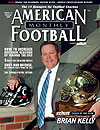Article CategoriesAFM Magazine
|
Pistol Spread Option Offenseby: Anthony M. PratleyHead Coach, Leonardtown High School (MD) © More from this issue The pistol offense is one of the latest crazes in football. Ever since Coach Chris Ault at the University of Nevada introduced it to the world, the variations have exploded across the high school and college ranks. Having been a spread option (Navy and Air Force-style) and spread offense coach, I decided to take a closer look at the pistol and have since adopted my own variation of it known as the Pistol Spread Option Offense.
|
|
|||||||
| HOME |
MAGAZINE |
SUBSCRIBE | ONLINE COLUMNISTS | COACHING VIDEOS |
Copyright 2025, AmericanFootballMonthly.com
All Rights Reserved





